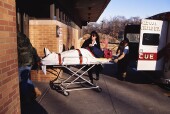 |
 |
 |
||
    |
||||
|
||||

Experience Brings Better Angioplasty Outcomes
Patients treated by skilled doctors at high-volume hospitals do best, study finds|
|
HealthDay
By Kevin McKeever
Wednesday, February 11, 2009
 WEDNESDAY, Feb. 11 (HealthDay News) -- The chances of a person surviving a heart attack roughly double if the victim receives treatment quickly from a doctor and facility experienced in the use of angioplasty and stents, a new study shows.
WEDNESDAY, Feb. 11 (HealthDay News) -- The chances of a person surviving a heart attack roughly double if the victim receives treatment quickly from a doctor and facility experienced in the use of angioplasty and stents, a new study shows.
Experts generally view percutaneous coronary interevention (PCI), which uses angioplasty and a stent to clear blood clots and then hold the artery open, as the best treatment for heart attack -- as long as it can be done shortly after the cardiac event. Primary PCI treatment programs are becoming more common throughout the country.
The study, published in the Feb. 17 issue of the Journal of the American College of Cardiology, found that heart attack victims in New York state had the best survival rate if they were treated in hospitals that performed more than 50 primary PCIs a year by doctors that had done at least 11 of the procedures during the same time period.
In general, the risk of dying in these high-volume hospitals was 42 percent lower than at a hospital dealing with 50 or fewer primary PCI cases a year. Those patients treated by the more experienced PCI physicians had a 34 percent lower risk of dying in the hospital overall compared to those under the care of physicians who had performed 10 or fewer PCI cases.
"Even in this day of advanced technology and advanced training, physician and hospital volume still matter, and they matter most in high-risk patients," researcher V.S. Srinivas, an associate professor of clinical medicine at Montefiore Medical Center in New York City, said in a news release issued by the journal's publisher. "In coronary interventions, nothing is higher risk than a heart attack."
The association between experience and death rate held even when the age and prior health of the patients was considered.
"Even in high-volume hospitals, higher-volume physicians did better than lower-volume physicians. We would expect the same effect in low-volume hospitals," Srinivas said. "Therefore, it's all the more important that community hospitals that are developing primary PCI programs have experienced physicians."
HealthDay
Copyright (c) 2009 ScoutNews, LLC. All rights reserved.
Related News:
More News on this Date
Related MedlinePlus Pages:
| Home | Health Topics | Drugs & Supplements | Encyclopedia | Dictionary | News | Directories | Other Resources | |
| Disclaimers | Copyright | Privacy | Accessibility | Quality Guidelines U.S. National Library of Medicine, 8600 Rockville Pike, Bethesda, MD 20894 National Institutes of Health | Department of Health & Human Services |
Date last updated: 12 February 2009 |
